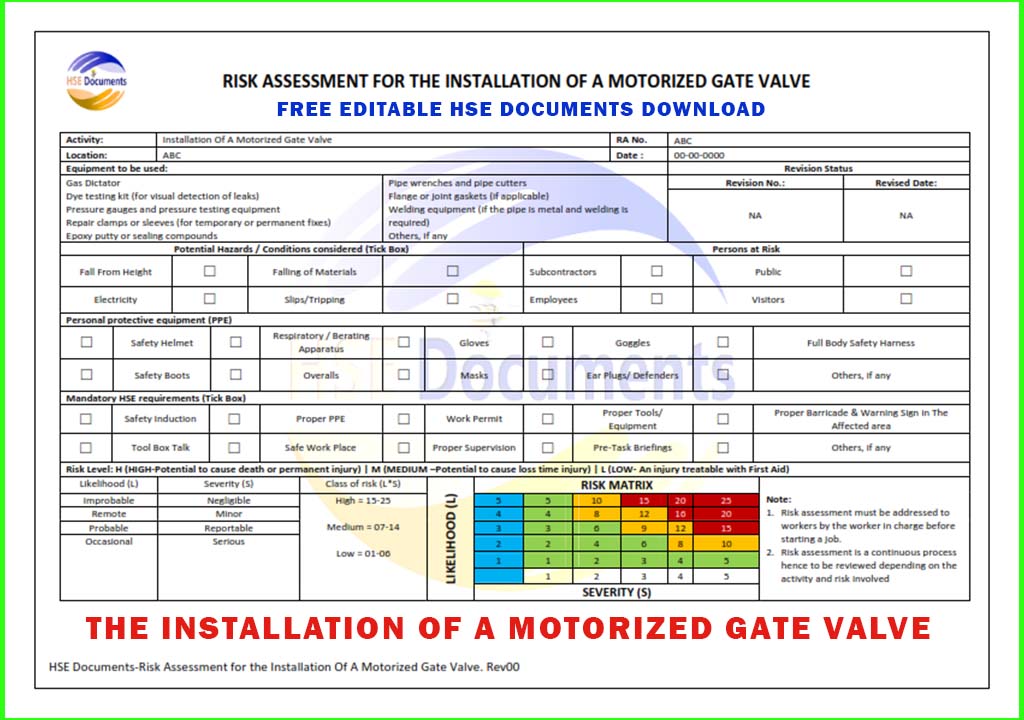The following are some of the hazards and control measures for the risk assessment for the installation of a motorized gate valve uploaded by the HSE Documents. For complete risk assessment, click the link given at the bottom of these lines.
Risks, Hazards, and Control Measures:
1. Electrical:
Risk: Electric shock or electrocution when working with electrical components.
Hazard: Live electrical wires or components.
Control Measures:
Ensure that power sources are de-energized and locked out/tagged out before starting any work.
Use proper personal protective equipment (PPE) such as insulated gloves and safety goggles.
Follow electrical safety protocols and guidelines.
2. Mechanical:
Risk: Injuries due to moving parts or equipment.
Hazard: Moving gate valve parts and machinery.
Control Measures:
Install safety guards and barriers around moving parts to prevent access during operation.
Ensure proper training for personnel working with the equipment.
Conduct regular equipment inspections for wear and tear.
3. Falling:
Risk: Falls from heights when working on elevated platforms or structures.
Hazard: Unstable platforms, ladders, or scaffolding.
Control Measures:
Use fall protection equipment such as harnesses and safety nets.
Ensure proper installation and inspection of scaffolding and ladders.
Implement a buddy system when working at heights.
4. Chemical:
Risk: Exposure to hazardous chemicals during the installation process.
Hazard: Contact with lubricants, sealants, or cleaning agents.
Control Measures:
Provide Material Safety Data Sheets (MSDS) for all chemicals used.
Ensure proper ventilation and use of respiratory protection if needed.
Store and handle chemicals according to safety regulations.
4. Transportation and Handling:
Risk: Injuries while transporting and handling heavy valve components.
Hazard: Heavy and awkward valve parts.
Control Measures:
Use mechanical aids such as cranes or forklifts for lifting heavy components.
Train personnel on safe lifting techniques and provide proper lifting equipment.
Maintain clear pathways and ensure a clutter-free work area.
5. Confined Space:
Risk: Working in confined spaces when installing valves in underground systems.
Hazard: Limited space, potential for toxic gases, or lack of oxygen.
Control Measures:
Conduct thorough atmospheric testing before entering confined spaces.
Implement a permit-to-work system for confined space entry.
Ensure workers are trained in confined space rescue procedures.
6. Environmental:
Risk: Environmental damage due to spills or leaks during valve installation.
Hazard: Accidental release of fluids or contaminants.
Control Measures:
Use spill containment measures such as absorbent materials and drip trays.
Have an emergency response plan in place for immediate spill cleanup.
Comply with environmental regulations and permits.
7. Communication and Coordination:
Risk: Miscommunication or lack of coordination among team members.
Hazard: Confusion, delays, and errors in the installation process.
Control Measures:
Implement clear communication protocols and roles/responsibilities.
Conduct regular team meetings to ensure everyone is on the same page.
Document installation procedures and follow a checklist.







1.jpg)


No comments:
Post a Comment